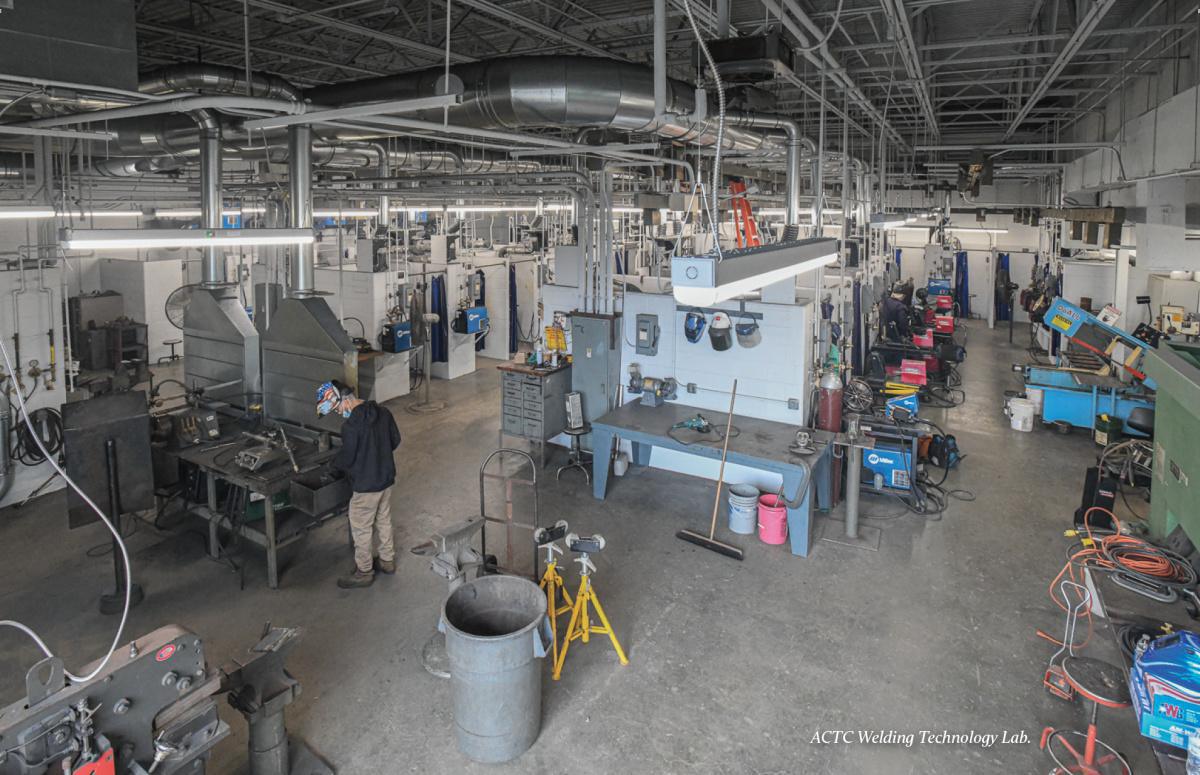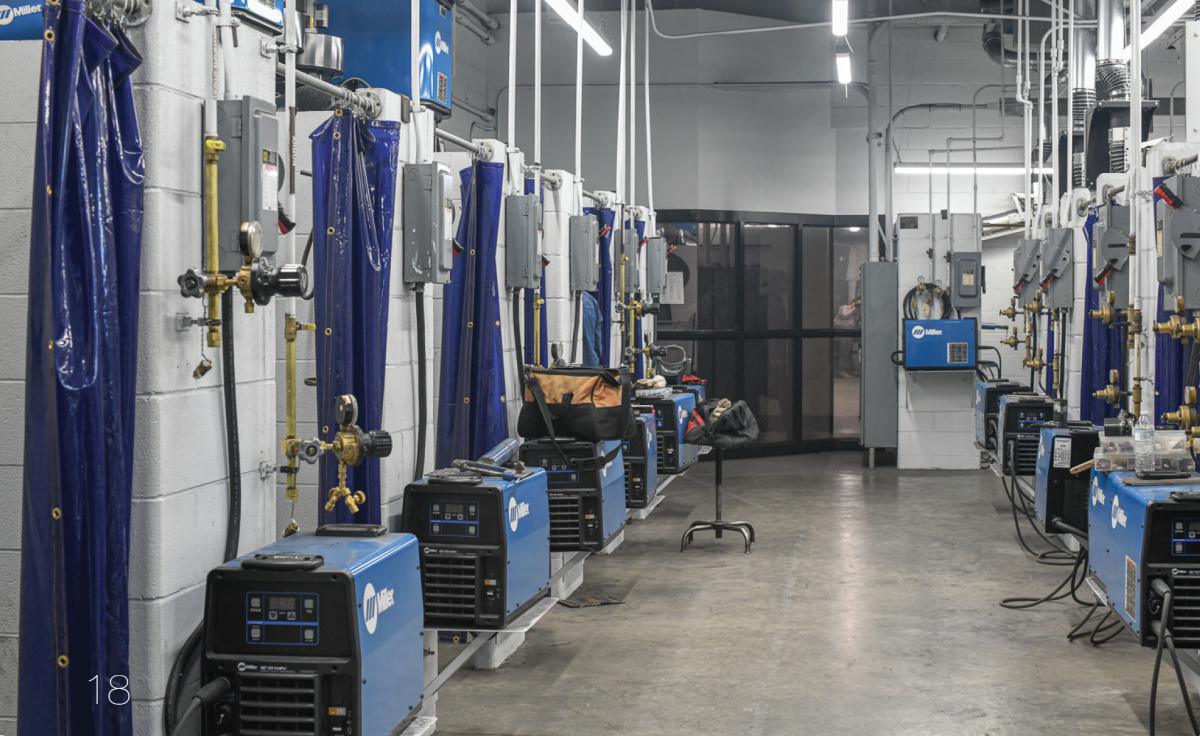The feel-good stories from the wildly successful welding technology lab at the Ashland Community and Technology College are as numerous as the sparks that fly from the more than 40 training booths that are daily developing some of the best welders in the world.
Courtney Stowers, a single mother of two who lives in Lavalette, West Virginia, is one of those. She started out in nursing and transferred into the welding program. Like so many others who took a similar plunge, it became life-altering.
“I like working with my hands instead of working in an office,” she said. “I like being able to build things and to work outside. Before this, I had jobs usually inside an office. That wasn’t me and it wasn’t for me.”
It was no surprise that Stowers excelled in what some may consider a male-dominated arena although there’s plenty of space for women, too. According to her, she grew up drag racing with the boys.
“I was usually around a bunch of guys doing most of the male-dominant sports. I gravitated more toward that instead of being behind a computer.”
However, she readily admits welding was a foreign subject to her, but she decided to give it a try anyway.
Stowers enrolled in the welding program and after 16 months she had her certificate. She became a member of the pipefitters union and now successfully supports her family with comforts she previously never thought possible.
“It’s probably one of the better-paying jobs in the Tri-State unless you’re like a lawyer or doctor,” she said. “Once I started looking into it, I was making more money than a nurse. It’s a little harder on you physically, but I’m a single mom with two kids and needed to have decent pay.”
Now, the program has another stamp of approval. It was recently named one of the top three in the nation in a ranking for America’s Best College for Vocational Certifications by Washington Monthly. The D.C. based magazine said the rankings were created using information from the U.S. Department of Education’s gainful employment database.
ACTC has the largest welding lab in the Commonwealth, along with a flexible program that fits any schedule. The program runs shifts of classes beginning at 6 a.m. and finishing around 2 a.m. So, it’s practically a 24/7 operation in developing proficient welders.
Now, a $750,000 investment from the school is pushing the program to even greater heights.
The welding lab is a sparkling shop with new welders and bays. It also has new paint and a ventilation system that meets all the new standards for clean air. The new system is exposed and hangs above the bays next to the shop lights. The lab is shiny with bright lights and blue curtains hanging in front of each numbered booth. Shop brooms, materials and gases are neatly placed on racks or walls, ready for students to learn. The college offers classes in the summer, on weekends and even during Christmas break to help train a 21st Century workforce in the skills of welding.
“United Association of Plumbers and Steamfitters Local 248 has worked closely with the college program for two decades,” said Curt Bowman, the coordinator and a professor in the welding program.
About 90 students per semester are taught, and they come from a lot of different scenarios. Some come fresh out of high school vocational schools, some have tried and failed at traditional colleges that offer four-year degrees and others, like Stowers, are trying to juggle school, family and work.
“We always want every student to succeed, and we’ve been very successful,” Bowman said. “If you stick with it, you’ll have a job waiting on you. It’s a beautiful skill and an addictive one. A Class A welder going to work at Marathon can make $25 to $30 an hour or more. After five years in a union, a pipefitter or millwright can bring in six figures if you’re willing to travel. It’s not about the income; it’s the outcome that matters to me. It’s not the money; it’s changing their lives. When they get the job, that’s what matters.”
Tristan Conrad, a 2016 high school graduate, went to ACTC for a year because that’s what high school counselors told him he needed to do. Conrad said he was an “average student” in high school who got lost in the shuffle.
“I went to work at minimum wage jobs. My dad had gone through the program and met Curtis. He knew I liked working with metal. Welding can be very addictive.”
It took Conrad five semesters, but he will join the workforce after the first of the year upon completion of the program.
“I’m very thankful,” he said. “It completely changed my life and widened my view of the world in general.”
“A lot of people don’t really know the scope of how well we’ve done with it,” said associate professor Jeff Cassady, who has been with the program for eight years as the evening instructor. “We’re now at the point, Curt and myself, where a lot of our students are now foremen and on the way to being superintendents.”
Cassady and Bowman said they don’t lecture as much as teach in the labs. “We’re dealing with students who are more hands- on anyway,” Cassady said. “When you can show them what you want to teach them, they seem to accept it better and they have more welding time.”
"The job opportunities are limitless especially for anyone who wants to travel,” said Cassady, who was a pipefitter himself.
Cassady said at plants like Marathon most things, such as pipes and structures, are touched by a welder. Other local structures also need a welding hand.
The program helps fill jobs in the area and beyond and provide good wages for people in the area. Even those who may work on jobs out of town still live in the area and bring back money, which Cassidy said pours that much more into the local economy.
Tom Wheeler is the other third of the teaching team. He is the midnight instructor.
Area high schools that have welding programs often send their graduates to ACTC, which trains them further and then connects them to the local 248 for testing and employment. The college offers a diploma program and eight different certificate programs, according to its website.
The diploma program is 48 to 55 credit hours, according to the website. The eight certifications are welder helper, gas welder, arc cutter, tack welder, production line welder, arc welder, pipeline welder, and AWS National Skills Standards Level 1. These certifications range from two to 34 credit hours.
The welding technology lab sits in a corner of a building located at the college’s Technology Drive campus just off the Industrial Parkway.
As the sparks fly from the new welders coming into the program every year, a world of opportunity waits for the 21st Century workforce.


